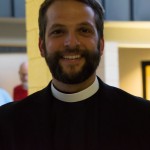I’m not a cradle Episcopalian. I’m a good ol’ Baptist boy turned zealous Anglican convert. I could say that I chose this Communion, but that wouldn’t be true. I was called here, drawn in. And one of the things that drew me into the Anglican tradition was the church year. It is, in my opinion, one of our greatest treasures as Episcopalians.
In it, we are immersed in the story of redemption. In it, we journey through the life and ministry of our Lord. In it, we live, year by year, the whole story.
And we need the whole story, not just the high points and not just the parts we like. The climax of an epic saga doesn’t make much sense if it’s siloed off from the rest of the story. For example, if you had never seen The Lord of the Rings trilogy, you wouldn’t start with the third movie. Sure, it might be cool to watch Frodo and Sam climb Mt. Doom to destroy the one ring, but the fullness of the victory would be lost on you.
We are now approaching the high point in the church year, the celebration of the apex of human history, the climax of the story of salvation: Easter. And the importance of the Resurrection of Jesus Christ cannot be overstated. As St. Paul so bluntly writes, “If Christ has not been raised, your faith is futile and you are still in your sins” (1 Cor. 15:17). In other words, there is no Christianity without the Resurrection.
But to get to Easter Sunday, we have to go through Good Friday. To get to Eastertide, we have to go through Lent. Christ’s victory at Easter must be understood in the light of the battle He fought with sin, death and the devil. It’s only when we realize all that He saved us from that we can truly rejoice in so great a salvation. Again, we need the whole story.
Lent is not a season that we fast forward through in order to get to the best part of the story. Nor is its essence left behind after 40 days. On the contrary, Lent is a season of intense emphasis of an ever-present aspect of the Christian life: repentance. Thus, Lent and Easter are inextricably linked.
In Colossians 3, St. Paul demonstrates how the crucified life (emphasized during Lent) and the resurrected life (emphasized during Eastertide) come together. He writes “Set your minds on things that are above, not on things that are on earth” (Col. 3:2). And why is it that we should set our minds on things above? “For you have died, and your life is hidden with Christ in God” (Col. 3:3). In holy baptism (see Rom. 6), we are united with Christ in His death. One life ends, and a new life begins.
But the vestiges of that old life hang around, which is why Paul urges us to walk in our baptismal identity by putting “to death, therefore, what in you is earthly: fornication, impurity, passion, evil desire, and greed (which is idolatry” (Col 3:5). But Paul continues in verse 12, “As God’s chosen ones, holy and beloved, clothe yourselves with compassion, kindness, humility, meekness, and patience.”
Now, the former exhortation (verse 5 and following) is the stuff of Lent, and the latter (verse 12) is the stuff of Easter. But we need both verses. We need both seasons. We need repentance and rejoicing. We need to recognize our sin so we can receive forgiveness. We need to look into the darkness that remains in us so the purifying light of the resurrected Christ can shine into our hearts all the brighter. And in the church year faithfully observed, we get all of the above and more.
We get the whole story.
– Father Matt Ainsley is assistant to the rector at Church of the Ascension in Orlando.


